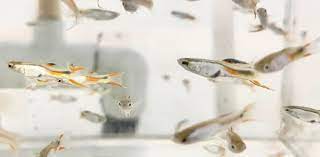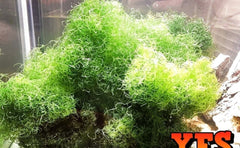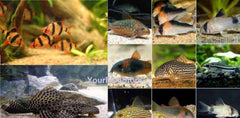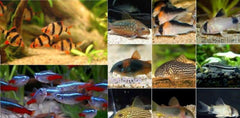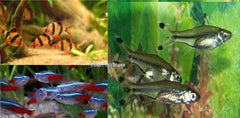Feeder Livebearer Half Box (150-225 Count)
Ebay
$ 143.53
Feeder Livebearer
Half Box (150-225 Count)
Type: xiphophorus sp
Care Level: Easy
Water Conditions: PH 6.5-8.5 and Medium hard to Hard
Temperature: 65-80??F (18-27??C)
Maximum Size: 2.5 inches (6.5 centimeters)
Natural Habitat
Poecilid livebearers are native to the southeastern United States, Mexico, Central America, northern South America and many islands of the Caribbean Sea. Guppies and mosquito fish have been introduced to many parts of Asia to help control malaria causing mosquitos and are now established in virtually all tropical and sub-tropical regions of the world. They inhabit streams, rivers, pools, lakes and estuary environments.
Water Requirements
Livebearers are native to hard, alkaline water but farm raised fish sold today will thrive in a wide range of water conditions. In nature they are often found in brackish to full marine environments and will benefit from the addition of 1 teaspoon of non-iodized aquarium salt per gallon of water. Make sure the other fish in your aquarium are tolerant of salt before deciding to add it. Most livebearers do best between 74?? and 78?? F. If the aquarium is kept in a room below 74?? F, use an Aqueon aquarium heater to increase the temperature. Maintain good filtration and do a 10% water exchange every two weeks or 25% once a month using an Aqueon Aquarium Water Changer or Siphon Vacuum Gravel Cleaner. Don???t forget to treat tap water with Aqueon Water Conditioner before refilling your aquarium!
Housing
Livebearers are top to mid-water swimmers and can be kept in aquariums of 2.5 to 20 gallons, however, larger aquariums are easier to take care of and give the fish more room to swim. They will be less stressed and show their best colors in a well decorated, dark bottomed aquarium with moderate current. Keep a secure lid on the aquarium to prevent fish from jumping out if they feel scared or threatened.
Behavior/Compatibility
Male livebearers can be aggressive towards each other and are constantly trying to mate, so a ratio of 2 to 3 females per male is advised to prevent excessive harassment of the females. Most livebearers live 5 to 7 years. Good tank mates include tetras, rasboras, danios, peaceful barbs and rainbowfish. Always consult an aquarium expert before buying any new fish for your aquarium.
Feeding
Livebearers are omnivores and need both vegetable matter and meat based foods. They will thrive on Aqueon Tropical Flakes, Color Tropical Flakes and Spirulina Flakes, as well as Aqueon Betta Treat. Frozen and live foods can also be fed as treats or to help induce spawning and improve color. For best results, rotate their diet daily and feed only what they can consume in under 2 minutes, once or twice a day.
Breeding Level - Easy
Livebearers reproduce without any help from the aquarist. A wellplanted aquarium will give newborn babies a place to hide until they are big enough to swim with the other fish. Male livebearers have a rod-like anal fin, called the gonopodium, which they use to fertilize the females which can give birth approximately once a month. You can tell when a female is about to have babies by her enlarged abdomen and the appearance of a large dark spot near the back of her belly. Pregnant females can be placed in a hanging ???breeder net??� to prevent the babies from being eaten by other tank inhabitants.
??


Quick Supply Links - $3.99 Shipping On All Supplies
Protein Skimmers - Lights - Fish Food - Pumps - Aquariums - Chillers - Decorations - Food - Filters - Medication - Nets - Salt - Substrate - Sump Tanks - UV Sterlizers - Cleaning Supplies - Nets - Koi Nets - Substrate - CO2 - Coral Viewers

Ebay Livestock & Supplies
QUESTIONS & ANSWERS
Have a Question?
Be the first to ask a question about this.

